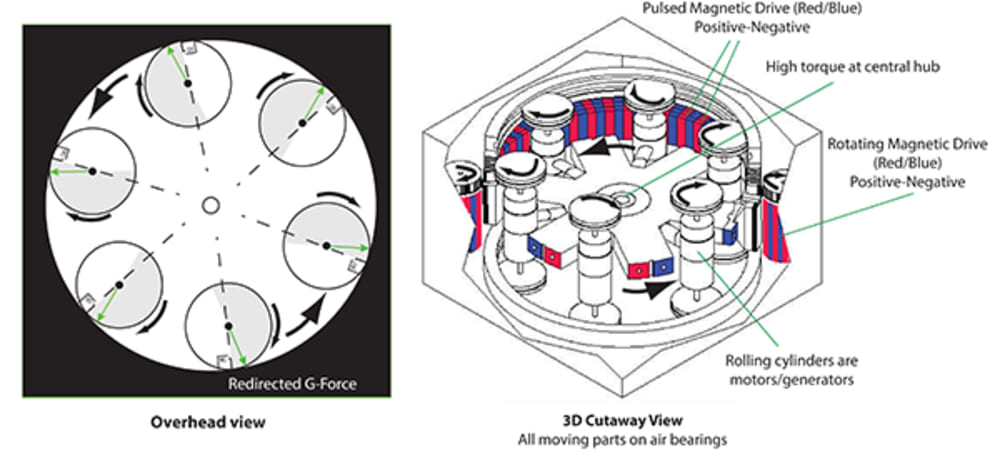We have invented a proprietary method to artificially offset the center of mass of a rolling object, forward of the center of rotation, thereby putting a rolling mass into an artificial state of unbalance. The method was proven when two carts were rolled down a slight inclined ramp with the subject cart having our technology and a comparison cart without. All other parameters were identical. Our subject cart accelerated faster and rolled further than the standard cart, in every attempt, multiple times. The experiment verified the mathematics that our proprietary technology draws upon a new source of kinetic energy.
We have conceptualized an electrical generation system that varies the input energy sources from predominately an external source at start-up to predominately internal at ideal RPM. The external source is a battery, and the internal source is the direct conversion of the effects of g-force into kinetic motion. The ability to add kinetic energy from this new internal source, means less energy input is required from an external source.
Important is the ability to increase RPM's and thus g-force and thus kinetic motion, in a highly efficient manner so that the gains realized by the conversion into g-force is not cancelled out by the increase in energy required to achieve the higher RPM's or by friction. This is accomplished by turning from outside-in, taking advantage of leverage. The system utilizes a highly efficient pulsed magnetic drive system, and air-bearings for minimal friction. Torque is high. When RPM's are doubled, the energy required to achieve the RPM's is also doubled (other devices it is typically quadrupled) but G-force is quadrupled. This affords the conversion of quadruple the g-force into kinetic motion without cancelling the gains.
Our generator does not create more energy than is used and always requires an outside source of energy. Under ideal operating parameters the energy flows will be 5% from the battery, 90% will be from the conversion of the effects of g-force directly into kinetic motion and 5% will be lost and unusable = 100% and a balanced conservation of energy equation.
The result will be a generator that can operate much longer with significantly far less outside "fuel" than a conventional generator. To create 30kW of energy, approximately 31.5 kW of energy will be utilized, however, unlike a conventional generator that utilizes a 100% external source of energy, our generator will only require 5% from an external source. This significant savings in external energy will afford 20x more operating time affording the recharging of the battery from any renewable sources including solar or wind.
Production and Application: Computer model key aspect discovering optimal material, computer model the generator based on simulation data. License 3D CAD models to manufacturers for use all modes of electric transportation, air, land and sea, as well as energy for all buildings. Assist in the implementation of product into the market.
Like this entry?
-
About the Entrant
- Name:Fred Ball
- Type of entry:individual
- Patent status:pending








